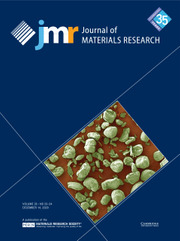Article contents
Microstructure characteristics and mechanical properties of a 2A66 Al–Li alloy processed by continuous repetitive upsetting and extrusion
Published online by Cambridge University Press: 01 July 2016
Abstract

Continuous repetitive upsetting and extrusion (CRUE) processing was performed to investigate its effects on microstructures, mechanical properties and texture characteristics of a 2A66 Al–Li alloy. The results show that the average grain size is effectively refined from initial as-extruded ∼140 µm to ∼4 µm after 3 CRUE passes. The grain refinement is the combined effect of continuous dynamic recrystallization and discontinuous dynamic recrystallization. The texture intensity tends to be weaker and new cube texture is gradually developed with increasing CRUE passes. In addition, the fraction of high angle grain boundaries increases to 86.37% after 3 CRUE passes. Tensile test results reveal that the ductility is greatly enhanced with modest reduction in strength after CRUE processing. The variation in mechanical properties may be mainly due to the decrease of dislocation density and weakening of texture.
Keywords
Information
- Type
- Articles
- Information
- Copyright
- Copyright © Materials Research Society 2016
References
REFERENCES
- 9
- Cited by


